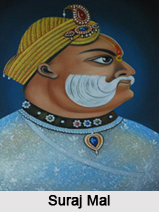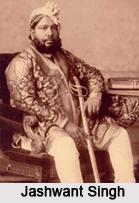 During British rule in India (which covers both the British East India Company rule and later the British Raj), the princely state of Bharatpur was ruled by different princes. They served the state as "Maharaja" and belonged to the Hindu Jat Dynasty. Given below are the rulers from the Sinsinwar Jat Clan and their ruling period.
During British rule in India (which covers both the British East India Company rule and later the British Raj), the princely state of Bharatpur was ruled by different princes. They served the state as "Maharaja" and belonged to the Hindu Jat Dynasty. Given below are the rulers from the Sinsinwar Jat Clan and their ruling period.
Brajendra Suraj Mal Bahadur
Brajendra Suraj Mal Bahadur was the 2nd Maharaja of Bharatpur. In the first half of the 18th century, Suraj Mal took significant part in the numerous encounters among the Mughals, Marathas, Rohillas and Afghans. He continued to extend his border until it included Agra.
Jawahar Singh
Jawahar Singh (1763-1768) is known to help Raja of Dholpur to attain freedom from the Marathas. He also made alliances with the East India Company against the Maratha Leader, Raghunath Rao. Jawahar Singh was succeeded by Ratan Singh who ruled Bharatpur from 1768 to 1769 who in turn was succeeded by Keshri Singh who ruled Bharatpur from 1769 to 1778
Ranjit Singh
 Ranjit Singh (1778-1805) had signed a treaty of alliance with the East India Company, followed it and maintained friendship with the British rulers throughout his life. This can be understood from the fact that the Maharaja supported the British against the Marathas and fought a battle with Lord Lake.
Ranjit Singh (1778-1805) had signed a treaty of alliance with the East India Company, followed it and maintained friendship with the British rulers throughout his life. This can be understood from the fact that the Maharaja supported the British against the Marathas and fought a battle with Lord Lake.
Randhir Singh
Randhir Singh (1805-1823) had abolished the huge army that was reducing peace due to delay in payment of salaries, reduced taxes and helped the British colonial power in reducing the terror of Pindaris. Baldeo Singh succeeded Randhir Singh and ruled Bharatpur from 1823 to 1825. He was in turn succeeded by Durjan Sal (1825–1826). Balwant Singh (1825 to 1853) was the next in line to succeed Durjan Sal.
Jashwant Singh
During Jashwant Singh"s tenure (1853-1893) loyal assistance was rendered to the British Government by Bharatpur, as the state supported British rule in the Revolt of 1857. Ram Singh then ruled Bharatpur from 1893 to 1900.
Kishen Singh
Kishen Singh (1918-1929) is credited with the reorganization of the army in 1919, making Hindi the state language, making primary education compulsory, establishing Ayurvedic hospitals, organizing an exhibition to promote trade and arts on an annual basis, establishing the Brij-Mandal in Shimla, enacting of the social reform acts, etc.
Brijendra Singh
Brijendra Singh was the last ruling Jat Maharaja (1929- 1947) of the Princely State of Bharatpur. He had signed the Instrument of Accession to the Dominion of India in August, 1947, thereby joining Bharatpur with the Matsya Union on 18th of March, 1948.



















